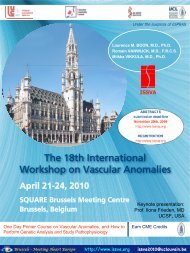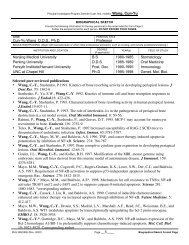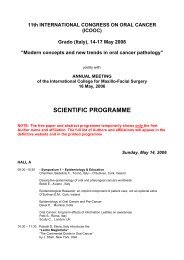core curriculum cleft lip/palate craniofacial anomalies
core curriculum cleft lip/palate craniofacial anomalies
core curriculum cleft lip/palate craniofacial anomalies
Create successful ePaper yourself
Turn your PDF publications into a flip-book with our unique Google optimized e-Paper software.
Core Curriculum for Cleft Palate and other Craniofacial Anomalies<br />
E. Preschool<br />
Nasal reconstruction may be performed just prior to kindergarten, possibly<br />
combined with a <strong>lip</strong> revision. These procedures are performed to improve<br />
function of the <strong>lip</strong> and nose, and to ensure that the child will look their<br />
best at a critical time of increased peer interaction when they begin school.<br />
F. School-Aged<br />
1. Dental concerns usually are primary during this time as orthodontics and<br />
alveolar <strong>cleft</strong> bone grafting are carried out.<br />
2. See the Orthodontics and Oral and Maxillofacial sections.<br />
G. Adolescents<br />
1. Some children with <strong>cleft</strong>s develop maxillary retrusion requiring jaw surgery to<br />
align their dental arches after their facial growth is complete (usually age 14<br />
to 18).<br />
2. After this is accomplished a final septorhinoplasty may be performed to<br />
improve breathing and nasal aesthetics.<br />
H. Adult<br />
1. Most patients have completed treatment by the time they reach<br />
adulthood.<br />
2. Surgical revision is usually successful in treating any residual problems.<br />
IX.<br />
Psychology and Clinical Social Work<br />
The psychologist provides evaluation of, and treatment for, emotional, learning,<br />
developmental, and adjustment disorders. This generally occurs within the context of the<br />
patient’s family. Particular attention is focused on the manifestations of appearance and<br />
speech on the patient’s self esteem and coping strategies for the patient and family in dealing<br />
with issues related to multiple operations. The clinical social worker may also focus on many<br />
of these concerns as well as using their expertise to obtain services when needed for patients.<br />
A. Prenatal<br />
Assist with prenatal counseling regarding future expectations of<br />
development and coping with the unexpected intrauterine diagnosis of a<br />
child with a <strong>cleft</strong> or <strong>craniofacial</strong> anomaly.<br />
B. Neonatal<br />
1. May assess high risk infants for risk of developmental disorders.<br />
2. May also assist parents with stresses related to children with facial deformity<br />
or other developmental problems.<br />
25<br />
© 2004 American Cleft Palate-Craniofacial Association
















